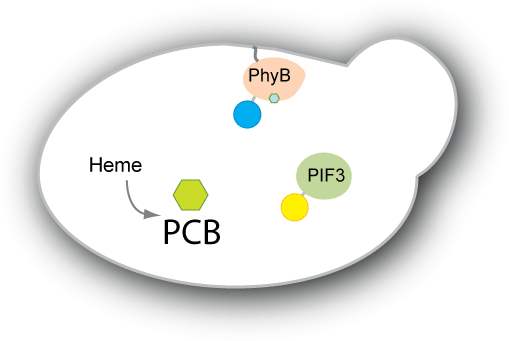Team:MIT
From 2009.igem.org
| Line 1: | Line 1: | ||
__NOTOC__ | __NOTOC__ | ||
| - | + | [[Image:Bilibuddies.jpg]] | |
| - | + | ||
| - | + | ||
| - | + | ||
| - | + | ||
| - | + | ||
<center>[[Team:MIT|Home]]|[[Team:MIT/Projects|Projects]]|[[Team:MIT/Protocols|Protocols]]|[http://partsregistry.org/cgi/partsdb/pgroup.cgi?pgroup=iGEM2009&group=MIT Parts for Registry]|[[Team:MIT/References|References]]</center> | <center>[[Team:MIT|Home]]|[[Team:MIT/Projects|Projects]]|[[Team:MIT/Protocols|Protocols]]|[http://partsregistry.org/cgi/partsdb/pgroup.cgi?pgroup=iGEM2009&group=MIT Parts for Registry]|[[Team:MIT/References|References]]</center> | ||
| Line 11: | Line 6: | ||
{| cellspacing="5" | {| cellspacing="5" | ||
| - | |width="70% | + | |width="70%" | |
<!-- Project Description HEADER with edit link--> | <!-- Project Description HEADER with edit link--> | ||
<h3>Project Overview</h3> | <h3>Project Overview</h3> | ||
<hr/> | <hr/> | ||
| - | |||
To maximize control over a biological system, it would beneficial to have quick, reversible control over each step in gene expression, from transcription to translation to post-translational processing. Much work has been done to create switchable promoters, toggled by pulses of light, to control rates of transcription for genes of interest. The MIT iGEM team aims to take this concept and apply it to post-translational control, more specifically protein targeting in yeast. Our goal is to make a system in which a pulse of light causes a protein of interest to localize to one part of the cell. When pulsed with another wavelength of light, the protein will diffuse. In this way, a user can easily control both localization and delocalization of a protein of interest. | To maximize control over a biological system, it would beneficial to have quick, reversible control over each step in gene expression, from transcription to translation to post-translational processing. Much work has been done to create switchable promoters, toggled by pulses of light, to control rates of transcription for genes of interest. The MIT iGEM team aims to take this concept and apply it to post-translational control, more specifically protein targeting in yeast. Our goal is to make a system in which a pulse of light causes a protein of interest to localize to one part of the cell. When pulsed with another wavelength of light, the protein will diffuse. In this way, a user can easily control both localization and delocalization of a protein of interest. | ||
| Line 29: | Line 23: | ||
Such a system would be useful in creating a reversible switch for many purposes. For example, one could synchronize a culture of cells in one part of the cell cycle without having to deal with temperature sensitive mutants or adding chemicals externally to arrest the cell cycle. The system would also be useful to study the kinetics of localization and delocalization, as well as provide an easy on-off switch for expression of essential genes. Light switchable transcriptional regulation has shown to be an effective way of increasing or decreasing gene expression quickly. By applying the concept of light switching to post-translational control as well, we aim to have greater control not only over gene expression, but also how the protein functions within the cell. | Such a system would be useful in creating a reversible switch for many purposes. For example, one could synchronize a culture of cells in one part of the cell cycle without having to deal with temperature sensitive mutants or adding chemicals externally to arrest the cell cycle. The system would also be useful to study the kinetics of localization and delocalization, as well as provide an easy on-off switch for expression of essential genes. Light switchable transcriptional regulation has shown to be an effective way of increasing or decreasing gene expression quickly. By applying the concept of light switching to post-translational control as well, we aim to have greater control not only over gene expression, but also how the protein functions within the cell. | ||
| - | + | |width="30%" | | |
| - | |width="30% | + | |
| - | + | ||
<h3>Members</h3> | <h3>Members</h3> | ||
<hr/> | <hr/> | ||
| - | |||
[[Image:MIT_logo.jpg|center|200px]] | [[Image:MIT_logo.jpg|center|200px]] | ||
<center>MIT Department of Chemical Engineering<br> | <center>MIT Department of Chemical Engineering<br> | ||
Revision as of 01:45, 22 October 2009
Project OverviewTo maximize control over a biological system, it would beneficial to have quick, reversible control over each step in gene expression, from transcription to translation to post-translational processing. Much work has been done to create switchable promoters, toggled by pulses of light, to control rates of transcription for genes of interest. The MIT iGEM team aims to take this concept and apply it to post-translational control, more specifically protein targeting in yeast. Our goal is to make a system in which a pulse of light causes a protein of interest to localize to one part of the cell. When pulsed with another wavelength of light, the protein will diffuse. In this way, a user can easily control both localization and delocalization of a protein of interest.
|
MembersMIT Department of Biological Engineering Undergraduates
Graduate
Professors
|
 "
"


